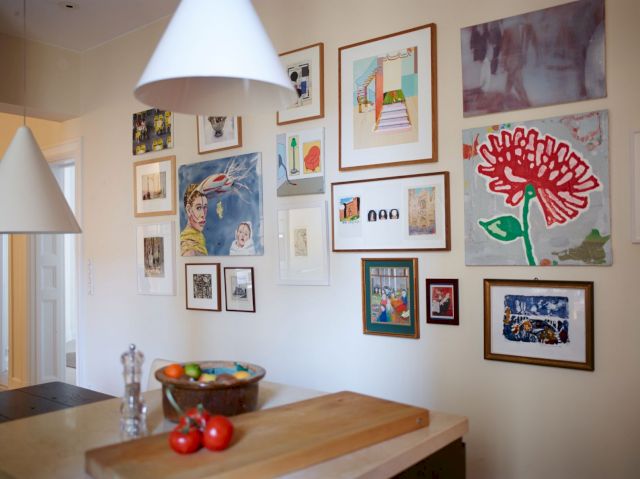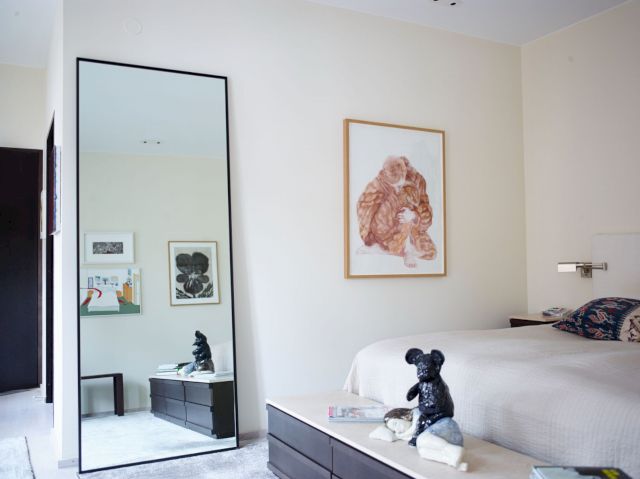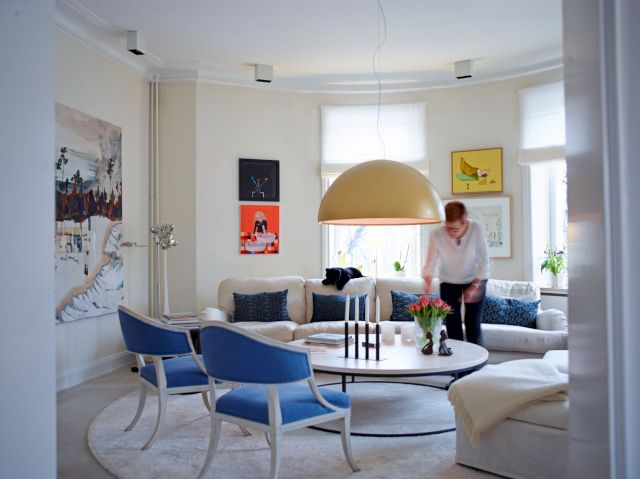Independent Collectors
Siw & Christer Ragnar
The afternoon sun filters into the large apartment of Siw and Christer Ragnar in Stockholm’s fashionable Tegnérlunden.

The afternoon sun filters into the large apartment of Siw and Christer Ragnar in Stockholm’s fashionable Tegnérlunden. There are still a few hours left before the joint opening that six leading Stockholm art galleries on Hudiksvallsgatan traditionally hold on the third Thursday of each month.
Where we are sitting, anticipation at the prospect of this evening’s opening is almost palpable. The apartment of Siw and Christer Ragnar is simply decorated with no color accents to conflict with the art on the walls. Every square meter of the walls is covered with oil paintings, art prints, watercolors or etchings. The floor, table and windowsills bear up sculptures and vases. Whether the evening will result in new company for them is distinctly unclear.
“Absolutely not”, Christer opines. “We have agreed not to buy anything at the moment.” “But that doesn’t actually stop us”, Siw counters.
The reason that they are not buying at the moment is that they are about to move house. Not that they have to move on account of the art in their collection, but because the new apartment will give them opportunities for storing art and for lighting the works on display.
The days count amounts to 150 artworks. Christer merely has to consult his smartphone to check the details. A specially designed app gives access to images of all the works. It also reveals where and when they were purchased and how much they cost. The app also discloses that 102 of the works are on display in the apartment, eight are in a closet while the remainder are with their two children, in their summer residence, or on loan to museums.
Initially the collection can seem wide-ranging verging on motley. But there is an obvious focus to it. “Our idea is to purchase living Swedish artists.” With few exceptions, all of the best-known Swedish names are represented: Karin Mamma Andersson, Lena Cronqvist, Maria Miesenberger, Jockum Nordström, Linn Fernström, Jan Håfström, Ernst Billgren, Dan Wolgers.
“We like to meet with and talk to the artists.” And even though in private they are more likely to meet gallery owners and other collectors, several leading artists have visited their home and some have offered to come and hang their works.
“We are part of a small group who go to openings together. Everyone goes to the same galleries.”




Siw and Christer’s interest in art began when they first met in 1972. They were both working in a bank in Gothenburg and had the opportunity to buy an oil painting by Erik Törning, one of the noted Halmstad painters. Christer consults his smartphone again. The painting cost them 3000 SEK, quite a large sum at the time. They still own this painting which sparked their interest in collecting art; an interest that developed into a passion when they moved to Stockholm in 1981. Now they had ready access to the most talked about exhibitions and galleries. When the children had grown up and their careers moved up a few notches they could afford to buy more expensive art and to experiment more.
For there is something that Christer is keen to emphasize: “Even if our taste has changed, we have not become more conservative. On the contrary, I would argue that we are more daring than ever in what we purchase today.”
Siw and Christer are curious about all sorts of art. On occasions they have even been captivated by a video installation.
“But if we are going to buy we have to be immediately struck by the work. If we are to make a purchase both of us have to be struck at the same time. Of course we have sometimes made a wrong decision. When the painting finally hangs on the wall it may no longer cause a frisson. It no longer works for us.”
“Every painting must be able to talk back to us. If it fails to answer back we begin to wonder. Why doesn’t it work here? And if this non-communication continues then we sell the work. But not until that happens.”

The painting must be able to talk back.
SIW AND CHRISTER RAGNAR
A Frank Stella sculpture provides an exotic element on a sideboard in one of the rooms. This resulted from a visit to the artist’s studio which was the high-light of one of the art trips that the Wetterling Gallery organizes from time to time. To gain an understanding of just how limited the Swedish art world is, Siw and Christer travel a great deal, particularly to the large art fairs in New York, London, Paris and Basel. Sometimes they even accompany Swedish artists exhibiting abroad. They are particularly grateful to the Wetterling Gallery which has allowed them to discover many exciting artists from other countries here in Stockholm. “There are few galleries that do this.” Björn Wetterling has been a background figure in their lives since their time in Gothenburg, but it was only a few years ago that they bought their first work via the Wetterling Gallery: a painting by the Israeli artist Diti Almog.
Otherwise it is Swedish art that interests them. Even youthful artists at the beginning of their careers. Given that they are both retired bankers one might conclude that they are engaged in some sort of venture capitalism with all the risks that are associated with it. Like buying shares in a new company. But both of them emphasize that everything they have bought they have bought because they like it and wanted to support the artist.
“If no one buys anything young artists can’t progress.” In fact most of the “youngsters” that they have bought have turned out to be a success from a pecuniary point of view. Which is probably merely the result of the fact that the more one looks at art over a long period, the better one becomes at distinguishing what is good from what is less good. Through practice one develops one’s eye, whether one is visiting a gallery or looking for an apartment. But does one have to be able to understand art?
“Perhaps one does not always need to understand. What is important is that you should be moved by the work. Though we might have passed over many fine works if we had not received a key to them from the artist. And if you are lucky with this, a whole new world can open up. Otherwise one can rely on Frank Stella’s dictum: ‘You see what you see’.”
If no one buys anything, young artists can't progress.
SIW AND CHRISTER RAGNAR

A Frank Stella sculpture provides an exotic element on a sideboard in one of the rooms. This resulted from a visit to the artist’s studio which was the high-light of one of the art trips that the Wetterling Gallery organizes from time to time. To gain an understanding of just how limited the Swedish art world is, Siw and Christer travel a great deal, particularly to the large art fairs in New York, London, Paris and Basel. Sometimes they even accompany Swedish artists exhibiting abroad. They are particularly grateful to the Wetterling Gallery which has allowed them to discover many exciting artists from other countries here in Stockholm. “There are few galleries that do this.” Björn Wetterling has been a background figure in their lives since their time in Gothenburg, but it was only a few years ago that they bought their first work via the Wetterling Gallery: a painting by the Israeli artist Diti Almog.
Otherwise it is Swedish art that interests them. Even youthful artists at the beginning of their careers. Given that they are both retired bankers one might conclude that they are engaged in some sort of venture capitalism with all the risks that are associated with it. Like buying shares in a new company. But both of them emphasize that everything they have bought they have bought because they like it and wanted to support the artist.
“If no one buys anything young artists can’t progress.” In fact most of the “youngsters” that they have bought have turned out to be a success from a pecuniary point of view. Which is probably merely the result of the fact that the more one looks at art over a long period, the better one becomes at distinguishing what is good from what is less good. Through practice one develops one’s eye, whether one is visiting a gallery or looking for an apartment. But does one have to be able to understand art?
“Perhaps one does not always need to understand. What is important is that you should be moved by the work. Though we might have passed over many fine works if we had not received a key to them from the artist. And if you are lucky with this, a whole new world can open up. Otherwise one can rely on Frank Stella’s dictum: ‘You see what you see’.”
If no one buys anything, young artists can't progress.
SIW AND CHRISTER RAGNAR




Siw and Christer are invited to an average of twenty to thirty openings and exhibitions each month. They go to as many as they can, but have difficulty in attending all of them. Particularly as they also have season tickets to Sweden’s National theatre, the Stockholm Concert Hall and the Royal Swedish Opera.
But wait just a moment. Isn’t one of the brightest stars of Swedish art missing from the collection? Cecilia Edefalk! Siw and Christer look slightly uncomfortable. That will be the next purchase. They have spread the word among the galleries and there have been suggestions. But the right item has yet to appear. And while they are waiting for Cecilia they need first to get the new apartment organized. How to hang each specific work is a matter that demands a great deal of thought. When they are just preparing to leave for the opening Siw tells me that she has a feeling that their new apartment does not have quite as many walls for hanging paintings on. But somehow or other everything will work out!
TEXT BY LENNART HÄGER
PUBLISHED BY WETTERLING GALLERY
IDEA & PRODUCTION BY LE BUREAU
“It’s Mine – A Tribute To Art Collectors” is a stunning 320 page book that portrays 33 Swedish and international art collectors and artists who have dedicated much of their lives to owning and creating art, supported with intimate interviews accompanied by personal portraits taken specifically for the publication.